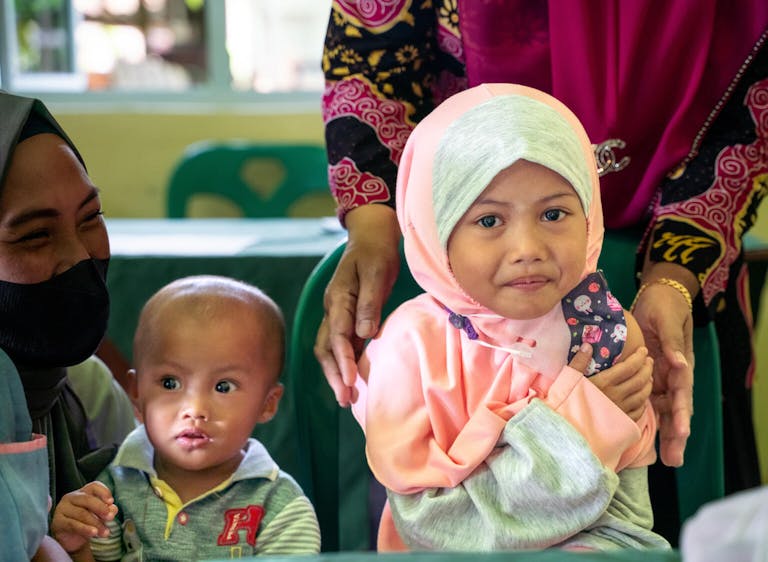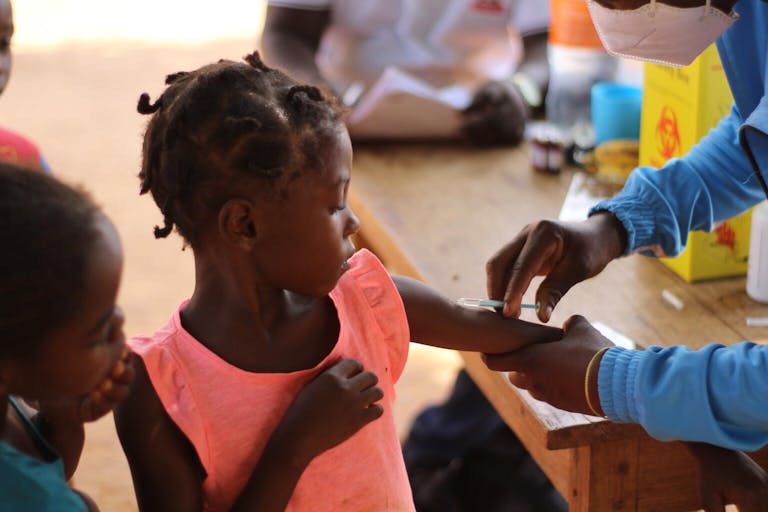Last updated July 26, 2023
Written by: Nico D’Auterive, Senior Global Health Communications & Advocacy Officer, United Nations Foundation
At first glance, the 2022 immunization coverage estimates released by the World Health Organization (WHO) and UNICEF this July seem promising. Four million more children received vaccines in 2022 than the year before, an essential step in ‘The Big Catch-Up’ to overcome losses in immunization coverage caused by the pandemic. However, as UNICEF and WHO have been quick to point out, such a simple interpretation of the data fails to recognize inequities in the recovery.
While several countries – primarily large, middle-income countries – have made impressive strides to improve diphtheria-tetanus-pertussis (DTP) vaccine coverage rates (a common indicator of immunization progress), low-income countries continue to lag behind, and measles immunization coverage remains low in most parts of the world. According to the Measles & Rubella Partnership (M&RP), there is an “urgent need” to catch up children who are missing measles vaccine doses.
Here is a deeper look into what the new data tells us about measles vaccination and what is being done to get back on track.

According to the new data, DTP immunization levels have almost recovered to pre-pandemic numbers in all regions of the world, except Africa. On the other hand, measles immunization rates have been slow to recover. Globally, only 83% of children received the first dose of measles vaccine (MCV1) in 2022, compared to 86% in 2019. This puts the world well below the recommended 95% coverage required to prevent outbreaks.
In low-income countries, MCV1 coverage was already suboptimal at 71% in 2019 and has further declined to 66% in 2022. Only the Eastern Mediterranean Region (EMRO) has gotten back to pre-pandemic coverage levels for MCV1.
Conversely, global coverage for the second dose of measles vaccine (MCV2) actually increased from 2019 to 2022 – from 71% to 74%. However, this improvement is largely the result of 13 additional countries having introduced MCV2 into their schedule since 2019. If considering only the countries that had introduced MCV2 before 2019, the coverage falls 1% below 2019 levels.
Most countries administer the first DTP dose to infants at six weeks and the first MCV dose at nine months. High “dropout” rates, that is how many children receive the first dose of a series but not subsequent ones, are a major challenge for many countries. Globally, the dropout rate is especially high between the first and second doses of DTP (6%) and between DTP1 and MCV1 (9%). In low-income countries, an alarming 18% of children who received DTP1 failed to go on to receive MCV1 in 2022.
Many factors can contribute to immunization dropouts, from lack of information about immunization schedules and difficulty reaching immunization services to lost vaccination cards. There are also health system factors that may contribute to the problem, such as poorly arranged and coordinated immunization services, vaccine and supply stock outs, and lack of viable dropout tracking systems.
Trust, both in local health care providers and in vaccines, also plays an important role in ensuring immunization completion. Unfortunately, many communities have seen a drop in this trust since the beginning of the pandemic. The State of the World’s Children 2023 report, released by UNICEF in April, indicates that confidence in childhood vaccines declined by up to 44% in some countries during the COVID-19 pandemic. The pandemic also exacerbated barriers to vaccine completion by disrupting routine vaccination activities and putting strain on the supply chain.

The slow recovery of measles immunization post-pandemic is especially concerning, given the virus’ highly infectious nature and its tendency to spread among already vulnerable populations. Measles can have severe complications, such as pneumonia, brain damage, deafness, and blindness, and is sometimes fatal.
Where gaps in immunity exist within communities, measles is often the first disease to spread. Though measles can occur in any country, the highest burden of death is in low-income and conflict-prone countries where the most vulnerable children already lack a safe and secure environment, stable and healthy nutrition, and access to universal health care.
With global measles immunization rates well below the recommended 95%, countries are increasingly experiencing “large or disruptive outbreaks” (defined as 20 or more reported cases per million population over a period of 12 months). From May 2021 to June 2023, the number of large or disruptive measles outbreaks more than doubled.
Such outbreaks occurred before the pandemic, especially in countries where coverage was below 95% for prolonged periods. However, now coverage has fallen even lower than pre-pandemic levels. If rapid action is not taken to catch-up the large numbers of under or unvaccinated children in many countries, the risk of wide-spread measles outbreaks will continue to increase.
In the recently published “The Big Catch-Up: An essential immunization recovery plan for 2023 and beyond,” recognizing the growing risk of outbreaks and risk of exposure to certain diseases, Immunization Agenda 2030 partners ask countries to consider prioritizing strategies to quickly reach children with the measles-rubella vaccine, as well as those for polio, yellow fever, DTP, human papillomavirus (HPV), and meningococcal A (where applicable).
Since 2000, the M&RP has supported delivery of millions of vaccines to children, helping to prevent an estimated 56 million deaths from measles. In a recent statement, the M&RP said it will continue to plan and coordinate high-quality campaigns to vaccinate those who are missing doses, work to strengthen surveillance and laboratory capacity, improve routine vaccinations to reach the 95% coverage targets, and provide timely resources and support to respond to outbreaks.
In Africa, where coverage is especially low, WHO and its M&RP partners are collaborating with countries to prepare for expected measles outbreaks. To ensure effective implementation of response plans and enhance national capacity, WHO has conducted regional workshops and provided technical support. The STOP Program, a collaboration between the United States Centers for Disease Control and Prevention, WHO, and UNICEF to deploy skilled public health professionals (originally to combat polio), has also played a vital role in strengthening measles outbreak prevention capacity in priority countries.
These are just some of the initiatives underway to prevent and control the spread of measles. Countries and global health partners can learn from these examples and from successful immunization catch up campaigns as they address vaccine inequities and work to ensure every community and every child is protected against preventable diseases.
Nico D’Auterive is a Senior Global Health Communications & Advocacy Officer at the UN Foundation. Prior to joining UN Foundation, Nico oversaw global, national, and local communications campaigns in the US and abroad with various NGOs, including Doctor’s Without Borders (MSF) and FXB International. She has worked in Haiti, Ukraine, Nigeria, and Colombia. Nico holds a master’s in international development and global health from the Paris Institute of Political Studies (SciencesPo) and an undergraduate degree in Anthropology from Columbia University.
To get the latest Global Health news from experts like Nico, subscribe to our monthly newsletter.